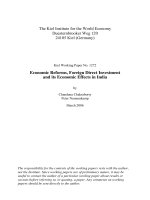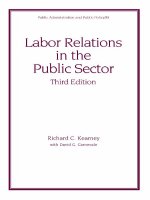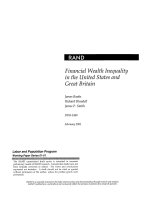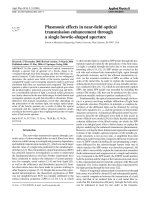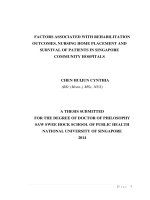Housing wealth effects in singapore public housing versus private housing
Bạn đang xem bản rút gọn của tài liệu. Xem và tải ngay bản đầy đủ của tài liệu tại đây (981.55 KB, 62 trang )
HOUSING WEALTH EFFECTS IN SINGAORE: PUBLIC
HOUSING VERSUS PRIVATE HOUSING
CHEN SHILU
(MASTER OF SOCIAL SCIENCES), NUS
A THESIS SUBMITTED
FOR THE DEGREE OF MASTER OF ECONOMICS
DEPARTMENT OF ECONOMICS
NATIONAL UNIVERSITY OF SINGAPORE
2010
Acknowledgement
It is my pleasure to express the deepest appreciation to those who has helped me with
this thesis.
I owe sincere gratitude to my most respected supervisors, A/P Anthony Chin Theng
Heng, and A/P Sau Kim Lum, for their patience, encouragement and illuminating
guidance. Through the period of the writing of this thesis, they have spent much time
on each of my drafts and offered me many valuable suggestions. I want to thank them
for generously sharing me with their knowledge and time. Without their help, this
thesis could not have been completed.
i
TABLE OF CONTENTS
SUMMARY ................................................................................................. III
LIST OF TABLES ...................................................................................... IV
LIST OF FIGURES ......................................................................................V
1. INTRODUCTION .................................................................................... 1
2. LITERTATURE REVIEW...................................................................... 7
3. MAIN CONTRIBUTIONS .................................................................... 16
4. THEORETICAL FRAMEWORK ........................................................ 18
4.1 STANDARD LIFETIME BUDGET CONSTRAINTS ....................................... 19
4.2 PRIVATE HOUSING WEALTH EFFECTS ................................................... 22
4.3 PUBLIC HOUSING WEALTH EFFECTS .................................................... 23
4.4 CPF WEALTH EFFECTS ......................................................................... 26
5. EMPIRICAL STUDIES ......................................................................... 28
5.1 DATA...................................................................................................... 28
5.2 METHODOLOGY .................................................................................... 32
5.3 EMPIRICAL RESULTS ............................................................................. 34
5.3.1 Private Housing Wealth Impact On Consumption ......................... 34
5.3.2 Private Housing Wealth Impact On Consumption In Different
Sub-Periods ............................................................................................... 37
5.3.3 Impulse Response Analysis Of Private Housing Wealth Impact
On Consumption ........................................................................................ 39
5.3.4 Public Housing Wealth Impact On Consumption ........................... 44
5.3.5 Public Housing Wealth Impact On Consumption In Different
Sub-Periods ............................................................................................... 45
5.3.6 Impulse Response Analysis Of Public Housing Wealth Impact On
Consumption .............................................................................................. 48
5.3.7 Asymmetric Wealth Effects Of Private Housing On Consumption. 49
6. CONCLUSION ....................................................................................... 51
BIBLIOGRAPHY ....................................................................................... 53
ii
Summary
This study aims to explore whether appreciation in housing prices affects
consumption in Singapore, and whether private housing and public housing exhibit
different wealth effects. Using aggregate data, the empirical results show no
significant private housing wealth effects or public housing wealth effects in the
Q1:1975-Q4:2009 period and Q1:1990-Q4:2009 period respectively. Nevertheless,
there is evidence of asymmetric effects in private housing market, with consumption
responding significantly towards price increases while remaining stable during price
downturn. It is also observed that there was a structural change in public housing and
public housing wealth effects started to be significant in 2003, when a series of
policies were introduced to boost the public housing market. The role of the Central
Provident Fund (CPF) is extensively examined in this study. The results show that the
CPF wealth effects are not statistically significant. However, the shocks in the
balances of the CPF accounts tend to have a more persistent impact on consumption
compared to housing wealth shocks. Additionally, the CPF is found to have a positive
and significant impact on public housing prices though its influence on private
housing prices is limited.
iii
LIST OF TABLES
TABLE 1: ..................................................................................................... 31
TABLE 2: ..................................................................................................... 35
TABLE 3: ..................................................................................................... 35
TABLE 4: ..................................................................................................... 36
TABLE 5: ..................................................................................................... 38
TABLE 6: ..................................................................................................... 38
TABLE 7:. .................................................................................................... 43
TABLE 8: ..................................................................................................... 44
TABLE 9: ..................................................................................................... 45
TABLE 10: ................................................................................................... 46
TABLE 11: ................................................................................................... 46
TABLE 12: ................................................................................................... 48
TABLE 13: ................................................................................................... 50
iv
LIST OF FIGURES
FIGURE 1 ...................................................................................................... 4
FIGURE 2 ...................................................................................................... 6
FIGURE 3 ...................................................................................................... 6
FIGURE 4 .................................................................................................... 30
FIGURE 5 .................................................................................................... 31
FIGURE 6 .................................................................................................... 31
FIGURE 7 .................................................................................................... 40
FIGURE 8 .................................................................................................... 40
FIGURE 9 .................................................................................................... 41
FIGURE 10 .................................................................................................. 49
v
1. Introduction
It has been widely observed that changes in property prices are associated with changes in
national consumption in many countries. According to the Permanent Income Hypothesis
(PIH) by Friedman (1957), consumption is equal to the annuity value of total wealth,
including human wealth and nonhuman wealth. The lifecycle model by Modigliani and
Brumberg (1955) also suggests that households accumulate and deplete their wealth to
keep their consumption roughly stable. Therefore, it is expected that households will
revise their consumption plan when they experience an unexpected change in their
housing wealth. Various empirical studies examine the housing wealth effects and
provide evidence of consumption responses to housing price changes. Bhatia (1987) and
Case (1992) found significant housing wealth effects with macro data in the United States.
Campbell and Cocco (2007), Case et al. (2005) and Engelhardt (1996) examined
household expenditures using micro data in different countries and concluded that
housing wealth effects were significant.
Unlike the United States, the United Kingdom and other developed countries, the
Singapore housing market consists of a dominant state-controlled public housing sector
and a small private housing market that is relatively less regulated. Public housing is a
unique feature of Singapore in that state-allocated units can be freely traded after a
stipulated period. However, its wealth effects have not been widely examined.
Nevertheless, public housing wealth effects cannot be ignored in the context of Singapore,
given that more than 88% of Singapore citizens live in the subsidised public housing
sector while private housing plays a limited role of supplying expensive residential units
to the higher income groups.
1
New public housing is directly provided by the state on a 99-year lease through its public
housing program managed by the Housing and Development Board (HDB), a sole agency
in charge of the construction and sale of public housing. As the only supplier in the new
public housing market, HDB offers different types of flats, including studio apartments,
units with 2 rooms to 5 rooms, and Design, Build & Sell Scheme (DBSS) flats. DBSS
flats were introduced in 2005 to involve the private sector in the development of public
housing so as to bring about greater innovation in building and design.
Demand for new public housing is also controlled as prospective buyers need to meet
certain eligibility conditions such as citizenship, income, family nucleus and age.
Specifically, eligible buyers must be Singapore Citizens and the family nucleus must
comprise at least another Singapore Citizen or Singapore Permanent Resident. Income
eligibility is adjusted by the government in accordance with the economic outlook and
affordability of its citizenry. The current household income ceiling for HDB flats is
$8,000. Households that are not eligible to buy new HDB flats may need to turn to the
private units or resale HDB flats sold in the open market. They could also buy Executive
Condominium, a hybrid form of private-public housing in Singapore if their income is
below $10,000.
The direct-purchase (new HDB) flats can be re-sold at market rates in the open market,
known as the resale market for public housing, only after a minimum holding period
(MOP) determined by HDB. Therefore, though HDB will not directly control the supply
of resale HDB flats, the MOP has some impact over the number of flats that are eligible
for resale. Currently, the MOP for direct-purchase HDB flats and resale flats is five years
from the effective date of purchase. In terms of demand, prospective buyers of HDB
2
resale flats still need to meet certain eligibility conditions albeit less stringent than those
for direct-purchase HDB flats.
Private housing experienced rapid price increases in the 1980s and 1990s due to
economic growth and an increase in demand for housing. Between 1986 and 1996, the
Singapore Private Residential Property Price Index (RPPI) increased by 440% in nominal
terms. However, prices fell by 45% between 1996 and 1998 due to government controls
and the Asian financial crisis. The private housing market recovered slightly between
1998 and 2000, and prices started rising in 2005 given the policies implemented to boost
the housing market.
The relaxation of foreign ownership rules on apartments, the
increase of the maximum loan-to-value ratio from 80% to 90%, the reduction of cash
down payments from 10% to 5% for home purchase, and permission for non-related
singles to use their CPF to jointly purchase private residential properties contributed to a
23.6% (20.9% in real terms) increase in the RPPI in 2007. In spite of the downturn
incurred during financial crisis in 2008, the improved economic conditions in 2009 and
low interest rates enabled the housing market to recover quickly.
Price movements in the public resale housing sector generally mirror those in the private
housing market, as shown in Figure 1. In 1993, the housing finance policy for resale HDB
flats was liberalised and flats were allowed to be financed based on market prices,
resulting in a boom of the resale market. Strong economic growth in the 1990s also led to
upward pressure on resale public housing prices. Resale public housing is sometimes
regarded as an inferior substitute of private housing. Singapore Permanent Residents
(SPR) buyers who could not afford private housing turn to resale public flats, and some
Singaporean households may prefer resale public flats to new units due to their
3
convenient location or the shorter waiting time to get the unit. A high immigration rate
and the impatience for new units have continued to support the demand for resale public
units and to push up the resale prices even during the crisis years.
Figure 1 plots both the private housing prices and resale public housing prices against
aggregate non-housing private consumption. There is a general simultaneity between
housing prices and consumption, though the simultaneity becomes weak during the
recessions in 1997 and 2008. This suggests that appreciation in housing prices is likely to
exert a positive influence on consumption.
200
25000
180
160
20000
140
120
15000
100
80
10000
60
40
5000
0
199001
199004
199103
199202
199301
199304
199403
199502
199601
199604
199703
199802
199901
199904
200003
200102
200201
200204
200303
200402
200501
200504
200603
200702
200801
200804
200903
20
Public Resale Index
Private Residential Index
0
Non housing consumption
Figure 1. Public housing, Private housing and Non housing consumption
Given the distinct institutional character of the residential sector, this paper distinguishes
between the public and private housing markets and attempts to explore the significance
of respective housing wealth effects in Singapore. It also tries to examine how the
Central Provident Fund (CPF) affects consumption. Singapore adopted a mandatory fullyfunded defined contribution system to cover a wide range of retirement, healthcare, home
ownership, family protection and asset enhancement needs. Working Singaporeans are
4
required to contribute a certain portion of their incomes, on a monthly basis, to their
individual CPF accounts that are managed by the CPF Board. The CPF members‟
contributions are channeled to three accounts: the Ordinary Account from which funds
can be used to buy a home, pay for CPF insurance, investment and education; the Special
Account for old age, contingency purposes and investment in retirement-related financial
products; and the Medisave Account for hospitalization expenses and approved medical
insurance. The Special Account is seldom touched by households due to its purpose to
serve retirement needs. Savings in this account, together with the leftover in the Ordinary
Account after home purchase and other expenditures, will be transferred to the CPF
Minimum Sum Scheme which ensures a minimal sum of money for Singaporeans during
their retirement years. The CPF members are not allowed to use the monies under the
CPF Minimum Sum Scheme for any form of investment. However, at age 55, members
can use the Minimum Sum to purchase an annuity, or to leave the savings in a bank or in
the CPF board. At the age of 62, the money would be released monthly to create a stable
annuity flow.
The CPF Public Housing Scheme (PHS) and the Residential Properties Scheme (RPS),
which were introduced in 1968 and 1981 respectively, allow CPF members to use their
CPF savings to pay for downpayment, stamp duty and mortgage payments incurred for
the housing purchase. The number of members who have utilised the two schemes to
finance their homes has been increasing steadily. The number of members under the PHS
grew from 2,900 in 1968 to 1.29 million at the end of 2007, while the number of those
under the RPS rose from 1,000 in 1981 to 226,000 in 2007. Presently, over 70% of flat
owners service housing loans solely with CPF savings. The withdrawal of the CPF
savings for housing moves closely the housing prices as shown in Figure 2 and Figure 3.
5
CPF schemes ease the financing burden of housing purchases and this paper attempts to
examine how the CPF may affect public and private housing wealth effects.
1800
200
1600
180
160
1400
140
120
1200
1000
100
80
800
600
60
40
400
0
198103
198203
198303
198403
198503
198603
198703
198803
198903
199003
199103
199203
199303
199403
199503
199603
199703
199803
199903
200003
200103
200203
200303
200403
200503
200603
200703
200803
200903
200
CPF withdrawal for private housing
20
0
Private Residential Price Index
Figure 2. CPF and Private housing price index
3000
160
140
2500
120
2000
100
1500
80
60
1000
40
500
CPF withdrawal for Public housing
200901
200801
200701
200601
200501
200401
200301
200201
200101
200001
199901
199801
199701
199601
199501
199401
199301
199201
199101
199001
0
20
0
Resale Price Index
Figure 3. CPF and Public housing price index
Moreover, CPF Members may invest their Ordinary Account balances under the CPF
Investment Scheme - Ordinary Account (CPFIS-OA) and their Special Account balances
6
under the CPF Investment Scheme - Special Account (CPFIS-SA), if they are confident
of earning a higher return than the CPF interest rates. Under the CPFIS, the CPF savings
can be invested in shares and loan stocks, unit trusts, government bonds, statutory board
bonds, bank deposits, fund management accounts, endowment insurance policies,
investment-linked insurance policies (ILPs), exchange traded funds (ETFs) and gold. It is
expected that the CPFIS may encourage households‟ investment in shares and enhance
the stock wealth effects.
Apart from the possible effects on housing and stock wealth, balances in CPF accounts
may directly affect consumption as a form of forced saving. According to the lifecycle
model, people smoothes consumption to prevent income uncertainty in the future, known
as precautionary saving. Therefore, CPF contributions reduce current consumption on the
one hand; but on the other hand, they enable households to be more prudent about their
future and retirement due to the accumulations in their CPF accounts. Asher (1999)
examined the economic impacts of the CPF, with a focus on the CPF adequacy for
retirement financing by reviewing the CPF investment schemes. This paper tries to apply
econometric methods to explore how the CPF affects Singapore housing prices and
consumption.
The remainder of this paper is organized as follows. Section 2 reviews relevant literature
followed by Section 3 which summarises key contributions of the paper. The theoretical
framework is provided in Section 4. Section 5 describes the data and statistics summary,
and documents the empirical results. Finally, Section 6 concludes.
2. Literature Review
7
Given the correlation between Singapore house prices and consumption shown in Section
1, it is tempting to attribute it to the housing wealth effect. However, it is crucial to
understand how consumption is determined, and whether wealth is causal to consumption.
Keynes (1936) marks the start of modern consumption theory by exploring the
relationship between consumption and income in his General Theory. He views
consumption as a function of current income, and claims that the marginal propensity to
consume (MPC), as well as the average propensity to consume (APC), falls with income.
Inspired by his work, other researchers extended his study on consumption theory.
Friedman (1957) views consumption as a function of wealth or permanent income, known
as the Permanent Income Hypothesis (PIH). The PIH maintains that households consume
a fixed fraction of their permanent income, the annuity value of lifetime income and
wealth, thereby introducing income expectations to consumption theory. The PIH implies
that the MPC is constant and equal to the APC, which is consistent with Kuznets‟ (1946)
findings that long run time series consumption data for the U.S. economy is characterized
by a constant aggregate APC.
Bilson (1980) provides empirical evidence for the PIH with tests on quarterly time-series
data from the U.S., U.K., and Germany. Flavin (1981) applies the test to aggregate
quarterly U.S. data and rejects the PIH. Weissenberger (1986) fits ARMA models to
adjust for the serial correlation of changes in consumption and rejects the PIH using
updated data for Germany and the U.K. Kim (1996) presents two alternatives and
examines whether PIH consumption is a good approximation of postwar U.S. data. He
finds that postwar U.S. consumption deviates from the PIH by less than 4 percent, which
8
indicates a reasonably good fit when viewed in a representative agent framework with so
many restrictive assumptions. More recently, using the Penn World Table annual data,
Dawson et al. (2001) report that the PIH holds in industrial countries but not developing
countries. However, the different results observed in industrial and developing countries
may be a result of systematic differences in data quality.
West (1988a) and Campbell and Deaton (1989) test the relation between the variance of
the revisions in consumption and the variance of the revisions in permanent income and
claim that changes in consumption are much less volatile than changes in observed
income. They reject the joint hypothesis implied in the PIH that per capita aggregate
consumption is generated by the permanent income model and that shocks to labor
income are permanent.
To differentiate the consumption response arising from different asset classes, Friedman
(1957) conjectures a lower MPC out of human wealth than out of financial wealth. Zeldes
(1989) later proposes to “put a weight of less than one on human wealth before adding it
to financial wealth, or to discount expected future income at a higher discount rate.”
Hayashi (1982) tests a generalized permanent income model, using a higher discount rate
for human wealth without using the theory of optimality. Wang (2006) further uses a
„risk-adjusted‟ measure for human wealth by calculating expected future income at a
higher discount rate based on the agent‟s optimality, and delivers a lower MPC out of
human wealth than out of financial wealth.
The introduction of the lifecycle theory by Modigliani and Brumberg (1955) is another
milestone in consumption theory as it introduces utility maximisation to the theoretical
9
framework. Individuals choose a lifetime pattern of consumption in order to maximise
their lifetime utility given their lifetime budget constraint which includes lifetime income
expectations. Lifecycle theory recognises that interest rates and time preference may
affect consumption, and that consumption may vary at different stages of life. The credit
market, specifically borrowing and lending, is also introduced to the theoretical
framework. Modigliani and Brumberg (1955) incorporate microeconomic choice theory
into macroeconomic consumption theory, and draw microeconomic implications with
cross-section data.
Modigliani and Brumberg (1980) further look at the time-series and macroeconomic
implications and conclude that households tend to average income over the life span, with
increases in life-time resources leading to proportionate increases in consumption in all
periods of life.
Subsequent literature has developed methods for dealing with uncertainty which is not
addressed in the Modigliani and Brumberg lifecycle model. Hall (1978) claims that
consumption is a random walk using time-series analysis and the theory of rational
expectations. Flavin (1981), Hall and Mishkin (1982), Hayashi (1982), Muellbauer (1983)
and Bernanke (1985) build their research on the random walk consumption. Flavin (1981)
argues that detrended per capita consumption exhibits excess sensitivity to predictable
changes in detrended per capita income. Mankiw and Shapiro (1985) further claim that
income can be well approximated by a random walk with drift, and the excess sensitivity
may be the spurious result of the presence of unit roots in the detrended per capita
consumption and income data. Hall and Mishkin (1981) and Bernanke (1985) intend to
analyse the correlations between the change in consumption and the econometric
10
estimates of contemporaneous or led innovations in other variables, but their work is
constrained by the fact that the true innovations are unobservable to agents.
Various work attempts to explain the motives of savings and consumption smoothing.
Carroll (1997) believes that people will never borrow even with uncertain future earnings
and the possibility of not being able to repay their debts, if they are sufficiently prudent.
Deaton (1991) also claims that people can save to smooth out their consumption, but they
cannot have consumption greater than their income, except when they already have some
assets in the bank. Consumption may also be smoothed over a few years when liquidity is
constrained, rather than over the whole life-cycle.
Clarida (1991) maintains that the MPC out of any permanent increment (in expectation)
to labor income during the working years will be less than one, as workers tend to save
more to finance higher consumption during retirement. Furthermore, the MPC out of
permanent shifts (in expectation) in labor income declines monotonically with age. Banks,
Blundell and Tanner (1998) observe that saving for retirement seems to start only in
middle-age, and is therefore insufficient to prevent a sharp fall in consumption at
retirement. The elderly do not dispose of their assets and indeed that many of the elderly
appear to save part of their incomes. Duesenberry (1948) documents „relative‟ income
hypothesis, which maintains that an individual‟s desire to consume increases with the
ratio of his expenditure to some weighted average of the expenditures of his contacts.
Merton (1971) shows that consumers maximise their expected utility and set consumption
to be proportional to their total assets when risk is confined to financial assets.
Gourinchas and Parker (2002) show the relative roles of precautionary and retirement
11
motives for accumulating liquid assets, and construct a measure of precautionary saving
and wealth. They indicate that wealth is accumulated early in life for precautionary
reasons. Households would instead borrow against future labor income if they are
sufficiently prudent.
Following Merton (1971), later studies examine the wealth effect of different asset classes.
Housing, as part of total assets, is also extensively examined. According to the PIH and
the lifecycle theory, an increase in housing value is likely to lead to an increase in
consumption. This housing wealth effects can be realised through several channels. First,
an appreciation in housing value increases the households‟ wealth and thus increases
consumption, which is regarded as direct wealth effects. Second, households that face
binding credit restrictions can borrow more against housing which can be used as
collateral in a loan. An increase in housing price relaxes credit constraints and allows
homeowners to borrow more to smooth consumption over the life cycle. This is regarded
as collateral effects or indirect wealth effects.
Various papers have provided empirical evidence for significant housing wealth effects in
different countries. Muellbauer and Murphy (1990) argue that the consumption boom in
the United Kingdom in the late 1980s could be attributed to the increase in housing prices
as well as financial liberalisation. Case (1992) finds substantial consumption increase
during the real estate price boom in the late 1980s using aggregate data for New England.
Skinner (1989) examines the link between housing wealth and consumer expenditure
using data on individual households from the Panel Study of Income Dynamics (PSID)
and found statistically significant housing wealth effects. However, the effects become
insignificant after correcting for heterogeneity among homeowners. Engelhardt (1996)
12
tries to examine the homeowners‟ marginal propensity to consume (MPC) out of real
capital gains, and obtained a MPC of 0.03 for Canadian households. Benjamin, Chinloy,
and Jud (2010) estimate the United States‟ consumption function using the value of the
real estate and financial wealth for the period Q1:1952-Q4: 2001 and find the real estate
would impose larger wealth effects on consumption compared to financial assets.
Campbell and Cocco (2007) use United Kingdom micro data to show that housing wealth
effects tend to be large for older homeowners and small for young homeowners. Case et
al. (2005) have done a comparison of housing wealth effects and stock wealth effects.
New measures of wealth are constructed for the cross-sectional analysis. Large housing
wealth effects are observed both across states in the US using quarterly data for the period
1982-1999, and a panel of 14 countries using annual data during the period 1975-1996.
Some researchers claim that high housing prices increase consumption through a lower
incentive to save. Yoshikawa and Ohtake (1989) apply micro data in Japan and find that
the net effect of higher housing prices is to increase consumption via a lower incidence to
purchase houses by households. Engelhardt (1994) claims that high housing prices lead to
a fall in the Canadian households‟ incentive to save for a down payment and an increase
in consumption.
Despite the evidence of housing wealth effects shown in numerous empirical studies,
there are some theoretical works posing doubt on such effects. Elliott (1980) argues that
housing would not exert as significant wealth effects as financial wealth. Sheiner (1995)
claims that households may actually increase savings due to higher down payment
requirements to purchase houses when housing prices increase, in contrast to the
conclusion by Engelhardt (1994). There are also quite a lot of empirical works that show
13
no evidence of housing wealth effects. Hoynes and McFadden (1997) find that
households would hardly change their savings in non-housing assets in response to
expectations about capital gains in owner-occupied housing. Levin (1998) claims that
homeowners do not consume their housing wealth which therefore would not affect their
consumption. Some skeptics of housing wealth effects believe that housing price
fluctuations would not affect the economy at an aggregate level as housing is a
consumption durable which is necessary for everyone. Sinai and Souleles (2005) provide
evidence that fluctuations in house prices would not have real wealth effects, because the
gain from higher housing prices is simply compensation for a higher implicit cost of
living in the house. The consumption choices may be affected if there are substitution
effects, and it may lead to the change in the distribution of consumption, but not the
change in the aggregate amount. Recently, Buiter (2008) finds that housing wealth gain
would be offset by higher housing costs during boom periods at the aggregate level, and
thus might not necessarily increase consumption. Psychological factors are also
considered as the cause of insignificance of housing wealth effects. Shefrin and Thaler
(1988) provide an explanation from the psychological perspective and claim that people
tend to take certain assets as more appropriate for current expenditures while take others,
such as housing wealth, as for long-term savings. Thaler (1990) further argues that
housing wealth would be classified into the mental account which is not for current
consumption, and thus would not lead to significant wealth effects.
A related branch of the literature suggests that house prices and consumption are
correlated as both are affected by a same third factor, rather than through housing wealth
effects. Calomiris et al. (2009) find no significant housing wealth effects after adjusting
for common macroeconomic factors.
14
The asymmetric effects of housing price increases and decreases on consumption have
also been explored. There is no consensus so far. Case et al. (2005) show evidence of
positive wealth effects when housing prices increase, but no significant effects when
prices decrease. This is in contrast to the conclusion by Skinner (1993) and Engelhardt
(1996) who find significantly negative effects on consumption when housing prices
decrease but no effects when prices increase.
Given contradicting findings in different literature, the significance of housing wealth
effects on consumption is likely to be an empirical issue, subject to econometric methods
and data analysis. Regarding the Singapore housing market, the empirical studies on
housing wealth effects have been all based on macro data due to the lack of micro data.
There is no consensus on whether the housing wealth effects are significant among the
limited research. Ng (2002) argues that private housing effects are significantly negative.
Phang (2004), using the same set of data, shows no significant direct wealth effects or
collateral effects based on the empirical results of both regressions when the CPF is
included or excluded in the measure of disposable income. Phang (2004) also finds an
asymmetric consumption response to increases and decreases of private housing prices.
Abeysinghe and Choy (2004) claim that housing wealth effects are insignificant in
Singapore. Co-integration of income and consumption did not exist, probably because the
sample period was not long enough for the two to exhibit long-run equilibrium. Edelstein
and Lum (2004) conclude that changes in public house prices would significantly and
persistently affect aggregate consumption, while there are no significant private housing
wealth effects in Singapore. These studies, however, have been constrained by the
limitations of data as public resale market was first introduced only in 1990. The high
15
multicollinearity of private housing and public housing also makes it difficult to
disaggregate the wealth effects.
In terms of econometric methods, Durlauf and Hall (1988, 1989a, 1989b) are the first to
develop a general framework for computing estimates of specification error or deviation,
which is treated as an unobserved component in a signal extraction problem in the model.
Campbell (1987) finds that saving, a linear combination of income and consumption is
stationary in its level under the PIH, though neither income nor consumption is stationary.
Therefore, he sets up a vector autoregression (VAR) and uses the theory of cointegration
in time series to test the model. Edelstein and Lum (2004) apply the vector-autoregressive
model with exogenous variables (VARX), followed by testing the impulse response of
consumption to different variables, to estimate wealth effects of both private and public
housing in Singapore.
3. Main Contributions
The contributions of this paper are as follows.
First of all, the role of the CPF is extensively examined in this study. To my knowledge,
this is the first paper which examines the wealth effects of balances in CPF accounts. It
considers the direct effects of the CPF on consumption as a standalone financial asset, as
well as the indirect effects through its influences on the housing and stock wealth. The
results show that CPF imposes a more persistent impact on consumption than housing
wealth. My interpretation is that the positive shocks to the CPF will lead to higher future
income, especially after retirement, and expected life-long resources are enhanced. This
shows that CPF is considered as nonhuman wealth or permanent income by households,
16
and the empirical study gives that the MPC of CPF is highest among all forms of
nonhuman wealth.
Second, it compares the wealth effects of private housing and public housing. Most of the
previous literature examined only the private housing market without taking the public
resale market into account. Although Edelstein and Lum (2004) examine the differences
between public housing wealth and private housing wealth, take both public and private
housing indices as measures of housing wealth and include them in one regression.
Additionally, the relatively short sample period may fail to result in a robust conclusion.
Different from Edelstein and Lum (2004), I regress aggregate consumption on private and
public housing wealth separately instead of putting them in one regression. This strategy
has several merits. It allows a much longer sample period when investigating the private
housing wealth effect. The RPPI is available since 1975 but the RPI is only available
since 1990. The separation of these two variables can enable a longer sample period for
the private housing regression. Moreover, it helps to overcome the multicollinearity
problem given that the correlation between the public and private housing is 0.9037 from
1990 to 2009. In the unreported robustness tests, I also follow Edelstein and Lum
(2004)‟s strategies and find that the results remain the same.
Third, this paper extends Phang (2004) and explores the asymmetric wealth effects in
private housing. More specifically, this paper includes the stock wealth and balances in
the CPF accounts in the model and further explores the asymmetric wealth effect in
housing. Phang (2004) applies the OLS method to study the contemporary effect of
housing wealth. However, Phang (2004) assumes no leads or lag effects and fails to
capture the dynamic features of housing wealth effect. In my study, a VAR method is
17
applied and the impulse response analysis helps to capture the dynamic features and
identify the cause-effect relationship. Moreover, in contrast to Phang (2004), the results
show that house price increases have a positive effect on aggregate consumption. One of
the explanations is that when private housing prices increase, homeowners tend to view
their private units as investment assets and are eager to reap the return from housing price
appreciation. The direct wealth effects are significant and consumption is increased.
However, during housing price depreciation, homeowners may tend to treat the private
housing for self-occupation rather than for investment, and stay in the current units so that
they will not lose in the depreciation. This result is consistent with Case et al. (2005)‟s
findings in the US housing market.
Last but not least, this study takes stock wealth as a control variable while previous
literature on Singapore housing wealth effects tend to ignore it in the regressions.1 While
our study provides an important implication of housing price, it should be admitted that
we do not have access to individual consumption data. As a result, this paper is unable to
evaluate the heterogeneity of housing wealth effect across income groups. However, it
can be concluded that housing wealth effect seems to be weak in general at least during
1975 to 2009 periods. More comprehensive studies will require micro-level data on
household consumption and we expect that the further researches might help to fill in this
important gap.
4. Theoretical framework
1
However, various studies have explored how the volatility in the stock market affects consumption in different
markets other than Singapore. For example, Elliott (1980) examined risky financial assets and concluded that stocks
influenced consumer expenditure in US. Starr-McCluer (1998) found differentiated stock wealth effects given different
responses from groups with different holdings. A survey exhibiting some time-series evidence of stock market wealth
effects was also shown by Poterba (2000). However, Case et al. (2005) found weak evidence of a stock market wealth
effect using both a panel of annual observations for 14 developed countries from 1975 to 1996, and another panel of
quarterly data for each of the US states for the period from 1982 to 1999.
18
4.1 Standard lifetime budget constraints
According to the Permanent Income Hypothesis and Lifecycle Model, identical
consumers choose
in each period t in order to maximize the utility conditional on the
information set in time t2:
(4.1) 3
subject to
(4.2)
(4.3)
(4.4)
where
and
is financial wealth in period t, r is interest rate,
is labor income in period t,
is the consumption in period t, T is the end of lifetime. This paper assumes that
the utility function is concave. The following is the solution for this maximization
problem:
(4.5)4
Therefore, (4.5) can be written as (4.6), assuming that the best prediction for
is the
2
is the conditional expectation on time t.
As indicated by Zeldes (1989), I assume that the discount rate equals to interest rate.
4
The model setup mainly follows Zeldes (1989). In this stylized model, the interest rate is assumed to be constant while
the prediction remains similar even given a stochastic interest rate. Edelstein and Lum (2004) take into account the
variance in interest rate and obtain similar results. Thus, the stochastic feature of interest will not influence our findings
3
19
